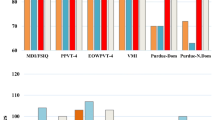Abstract
Purpose
Increasing incidence of pediatric brain tumors and improving survival rates encouraged us to assess long-term functional outcome of patients with cerebellar juvenile pilocytic astrocytoma (JPA).
Materials and methods
Our study encompassed 105 children treated since 1980–2005 and consisted in analysis of mailed, custom-designed questionnaires.
Results
Mean follow-up time was 8.3 years. Sixty out of 104 patients presented permanent neurological deficits and 47/104 presented significant behavioral disorders. Eighty-nine children continued their education at primary, secondary or high school level. Most patients and their parents were satisfied with treatment outcome. Patients’ and parents’ notes were usually concordant.
Conclusions
Long-term functional treatment outcome of cerebellar JPA is relatively favorable, in spite of permanent neurological deficits and emotional disorders in over half of the patients. Vermian tumors are associated with worse long-term functional outcome. Neurological deficits and emotional disorders do not preclude further education and independent functioning.

Similar content being viewed by others
References
Maryniak A, Roszkowski M (2005) Cognitive and affective disturbances in children after surgical treatment of cerebellar tumors. Neurol Neurochir Pol 39(3):202–206
Pencalet P, Maixner W, Sainte-Rose C (1999) Benign cerebellar astrocytoma in children. J Neurosurg 90:265–273
Bhat SR, Goodwin TL, Burwinkle TM et al (2005) Profile of daily life in children with brain tumors: an assessment of health-related quality of life. J Clin Oncol 23:5493–5500
Heimans JJ, Taphoorn MJB (2002) Impact of brain tumor treatment on quality of life. J Neurol 249(8):1432–1459
Varni JW, Katz ER, Seid M et al (1998) The pediatric cancer quality of life inventory (PCQL-32): reliability and validity. Cancer 82:1184–1196
Bampoe J, Siomin V, Bernstein M (2002) Quality of life assessment in neurosurgical patient. Neurosurg Q 12(2):132–141
Tao ML, Masterman-Smith M, Garvie PA et al (2004) Quality of life assessment (QUOLA) in pediatric brain tumor population: feasibility and measurement properties of a new brain-specific instrument. Neurooncology 6:448
Zakrzewski K, Fiks T, Polis L, Liberski PP (2003) Posterior fossa tumors in children and adolescents. A clinicopathological study of 216 cases. Folia Neuropathologica 41(4):251–252
Schmidt-Sidor B, Wierzba-Bobrowicz T, Krosno-Kruszewska E, Eibl M, Lechowicz W (2003) Neoplasm of posteriori cranial cavity in children—166 cases. Folia Neuropathologica 41(4):259–260
Shmahmann JD, Sherman JC (1998) The cerebellar cognitive–affective syndrome. Brain 121:561–579
Fiez JA, Raichle ME (1997) Linguistic processing. In: Schmahmann JD (ed.) The cerebellum and cognition. International review of neurobiology. vol 41:232-254
Steinlin M, Imfeld S, Zulauf P et al (2003) Neuropsychological long-term sequelae after posterior fossa tumor resection during childhood. Brain 126(9):1998–2008
Levisohn L, Cronin-Golomb A, Schmahmann JD (2000) Neuropsychological consequences of cerebellar tumor resection in children: cerebellar cognitive-affective syndrome in a pediatric population. Brain 123(5):1041–1050
Mackworth N, Fobair P, Prados MD (1992) Quality of life self-reports from 200 brain tumor patients: comparison with Karnofsky performance scores. Journal of Neurooncology 14(3):243–253
Mostofsky SH, Reiss AL, Lockhart P et al (1998) Evaluation of cerebellar size in attention-deficit hyperactivity disorder. J Child Neurol 13(9):434–439
Riva D, Giorgi C (2000) The cerebellum contributes to higher functions during development. Evidence from a series of children surgically treated for posterior fossa tumors. Brain 123:1051–1061
Jozefiak T, Larsson B, Wichstrom L et al (2008) Quality of life as reported by school children and their parents: a cross-sectional study. Health Qual Life Outcomes 19:6–34
Campbell JW, Pollack IF (1996) Cerebellar astrocytomas in children. J Neurooncol 28(2–3):223–231
Author information
Authors and Affiliations
Corresponding author
Rights and permissions
About this article
Cite this article
Daszkiewicz, P., Maryniak, A., Roszkowski, M. et al. Long-term functional outcome of surgical treatment of juvenile pilocytic astrocytoma of the cerebellum in children. Childs Nerv Syst 25, 855–860 (2009). https://doi.org/10.1007/s00381-009-0855-1
Received:
Revised:
Published:
Issue Date:
DOI: https://doi.org/10.1007/s00381-009-0855-1




